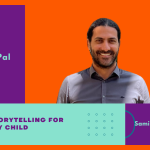Argil makes high-quality video creation faster, simpler, and more accessible. By integrating AI avatars, automated editing, and dynamic production tools, it enables corporations, educators, and creators to create professional video in minutes, without the need for expensive studios or difficult software.
1. What inspired the creation of Argil, and how does it align with your mission to make AI-driven video creation accessible?
Laodis Menard: I’ve created tons of video content over the years—movies, self-produced masterclasses, and even TikTok promos. Every project was expensive and time-consuming, especially with all the post-production work. I noticed that young people are almost exclusively into video, yet producing quality videos is really costly. When I saw that AI could now generate content and even clone people, it became clear: we had to build Argil. We built both the model and the platform because a good video isn’t just about a realistic AI avatar—it’s about blending solid pre-production, production, and post-production (editing) to make something engaging.
2. Argil allows users to create AI-generated videos in minutes. How does your technology differ from traditional video editing tools?
Laodis Menard: Our main goal is to make videos that truly engage your audience. We’re not just creating static avatars or basic videos; we’re creating dynamic content. One key feature is our ability to add and control body language—your avatar moves naturally. Plus, our platform comes with a bunch of presets and pre-edited features like captions, music, background changes, and dynamic camera angles. In short, we’ve streamlined production so you can make engaging videos without the usual hassle of traditional editing.
3. How does Argil ensure a balance between realism and efficiency in AI-generated videos?
Laodis Menard: We built our model from the ground up with video editing in mind. Think about it: no one ever watches a five-minute clip of someone standing still without any cuts or b-roll. We designed our system to include natural camera changes, zooms, and body language—features that make every clip feel dynamic. Once our model mastered these elements, generating several quality videos in just minutes became a reality.
4. Many AI-generated video tools struggle with authenticity. How does Argil enhance engagement while maintaining a human-like feel?
Laodis Menard: We let users customize their avatars in a way that feels real. You can choose different styles—imagine an avatar that’s walking down the street, chopping vegetables, or working out at the gym. Our avatars aren’t static; they display natural body language and facial expressions.
We also use high-quality, professional voices (complete with natural hesitations) and plan to add ambient background noises. All of these features work together to give your video a truly authentic, human feel.
5. How have businesses and content creators benefited from using Argil?
Laodis Menard: Argil lets you do so much more for a fraction of the cost. For example, if you’ve produced a masterclass, you can extract just a few minutes from a two-hour recording and then use that.
Snippet to train your avatar for an entirely new section. It opens up video creation to everyone—even those who previously couldn’t afford it. You can even transform a blog or press article into a video with just a few clicks, which is fantastic for creators focused on SEO or video blogging.
6. Can you share a specific example where Argil significantly improved a brand’s marketing or educational content strategy?
Laodis Menard: Absolutely. One of our biggest success stories comes from a content creator named Kwebblekop. He’s launched a full AI-driven channel, generating millions of views by automating his workflow via our API. This setup has allowed him to grow his channel continuously, and we’re already seeing many brands and creators follow in his footsteps.
7. What industries are leveraging Argil’s AI-generated videos the most?
Laodis Menard: We see three main industries:
- Press & TV: News outlets and media companies are transforming articles into engaging videos without the need for bulky production gear.
- Education: Infopreneurs, masterclass creators, and educational platforms can now produce more content quickly and cost-effectively.
- User-Generated Content (UGC): Anyone looking to sell products or build an online presence on social media can benefit from dynamic, affordable video production.
8. How does Argil cater to creators with different levels of video editing expertise?
Laodis Menard: Most of our users say they’re not professional editors. With Argil, they skip the heavy lifting of production and post-production. Our platform gives them ready-to-use outputs complete with
captions, transitions, music, and more. For those who do like to edit further, the output serves as a great starting point. We’re also rolling out integrations with automation tools like Make and Zapier, so users can feel more like directors—choosing the avatar, camera angles, and script—while leaving the nitty-gritty editing behind.
9. What challenges have you faced while scaling Argil, and how did you overcome them?
Laodis Menard: Building a state-of-the-art model was a huge challenge—especially since we entered the market later than some competitors and had significantly less funding. It took relentless engineering, research, countless client discussions, and endless testing. I remember our Y Combinator days: we set up a makeshift studio in an apartment and spent all day experimenting with how to perfectly match live shots to our avatar. It was all about grinding, grit, and trusting that our efforts would pay off.
10. Looking back, are there any strategic decisions you would approach differently now?
Laodis Menard: Honestly, we’re only about one year into the product, and most of our decisions have really paid off. So, I can’t say I’d change anything major at this point.
11. What does success look like for you and Argil in the next 5–10 years?
Laodis Menard: We want Argil to be the go-to video engine for the creator economy. I envision a future where almost every video on social media—and even on TV—could be created using Argil. Imagine people walking down the street with an app on their phone, effortlessly creating videos on the go, just like how early social media pioneers observed everyday users engaging with their platforms.
12. What does a typical day in your life as a founder look like, and how do you stay motivated?
Laodis Menard: Every day is a whirlwind—I make around 50 decisions daily in what I’d call organized chaos. My team is given massive ownership, and we’re constantly seizing new opportunities. It’s mostly about trusting the team, making rapid checks, and iterating quickly. I stay motivated because our mission is crystal clear, and seeing progress—both in market feedback and client success—gives me endless energy.
Editor’s Note
For Laodis Menard, video production was always too sluggish, costly, and technological. Argil changes that. Built from the ground up, it streamlines the entire process, allowing users to easily create captivating, professional-quality movies.
Discover more interviews with AI founders on the AIPressRoom Interviews page.



